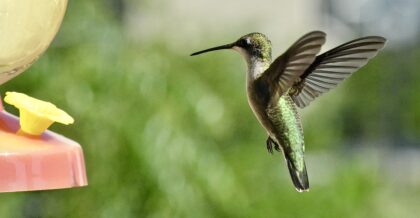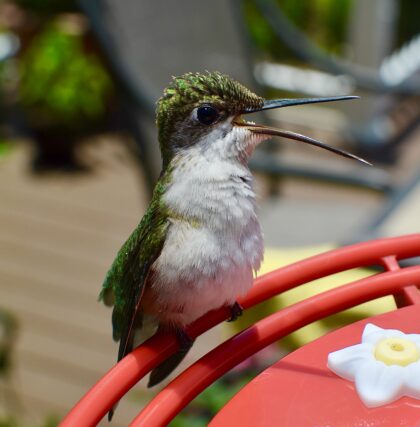
Something has been pulling the fake flowers off of our hummingbird feeder. Raccoons are the primary suspect. Hummingbirds don’t seem strong enough, and don’t need to tug at petals to feed. Also, the vandalism occurs overnight. Oh yeah, and there are the incriminating raccoon paw prints all around the feeder. Seemed pretty cut and dry. But then a headline about how “some hummingbirds are flower robbers” caught my eye. Maybe hummingbirds do engage in more than nectar sipping.
Very quickly I realized I had misunderstood the headline. The hummingbirds don’t steal flowers, they steal from flowers. Or in less anthropomorphic language, some hummingbird species are able to get nectar from plants without also picking up pollen. Nectar-for-pollen-dispersal is the usual exchange. Nectar is calorie dense. This makes it costly for plants to produce when it is consumed by other creatures, but that cost can be worthwhile if the consumers pick up pollen in the process and spread it to other plants, maintaining genetic diversity in the plant population. And hummingbirds need those calories for energy so they can flit about in their idiosyncratic fashion.
Of course, this is not a negotiated arrangement; the hummingbirds aren’t consciously pick up pollen granules and likely don’t even know it is happening. And the plants cannot rely on contract law to enforce the deal; their only option is to arrange their flowers in such a way that access to the nectar requires brushing up against pollen-laden stamens. This works well, but apparently not always. It assumes that the hummingbird is hovering when it sips, necessitating a particular beak angle. Some hummingbird species can get nectar from some plants by grasping the plant and reaching around to the flower instead of hovering. Depending on how the flowers are positioned relative to the rest of the plant and how the stamens and nectar are arranged, pollen may or may not transfer in the process. The hummingbirds likely are not deliberately avoiding the pollen; I doubt it costs them much to carry it. Instead, they are benefiting from the rest. They can use less energy to feed while grasping because they don’t have to flap their wings.
Despite making headlines, this different feeding strategy is not actually the primary finding of the paper (the final version will be here eventually; author’s PDF is here). Rather, it is an observation that prompted further investigation. The main findings are that this strategy has developed multiple times in the lineage of hummingbirds, and that it drives adaptations of the beak and feet. The species which grasp to feed have longer hind-toe claws and shorter beaks; the longer the claw, the shorter the beak. The correlation between the two suggests an adaptive relationship rather than random variations in size between species.

I keep talking about multiple hummingbird species. Did you know there are about 350 different species in the world? As Colwell et al. note, anyone familiar with these birds could accurately identify individuals from any of those species as hummingbirds but likely don’t appreciate the distinctions between them. The authors hypothesize that even the hummingbird research community is “distracted” by the striking features which are common to all hummingbirds and make them unique among other birds, including their hovering ability and their colorful plumage. As a result, differences in more pedestrian features like toe claws have been overlooked.
Reality is complicated and staggeringly diverse. If you look close enough, every individual hummingbird is unique, as are all the members of every other species. Of course, “close enough” may mean the microscopic or even genomic level, at which point we are dealing with billions of dimensions. Features like bill length or talon length could each be a dimension, as could measurements of various other body parts. Each position in the genome could be a dimension. Anything that we can use to distinguish two creatures could be a dimension, and we’d need many such dimensions to separate every living organism. Our brains don’t do well with billions of dimensions, and we don’t have the senses to perceive all those features nor the memory to store all the coordinates.
So to cope with all that diversity, we have to simplify. We need ways to reduce the number of dimensions to pay attention to; that process can be thought of as applying heuristics or coarse graining. We pay attention to key features and group things accordingly. All the birds that hover for an extended period of time are hummingbirds; details of claws and beaks are ignored. And we do the same all over the place, to varying levels based on necessity. We don’t need to tell hummingbirds apart, and they likely don’t mind. Dogs are more involved in our lives, so we not only recognize them as a distinct species of canid (the family dogs belong to, equivalent to the hummingbird family), but many of us can identify a variety of breeds and know one or more individuals by name. With humans, we can go further, generally recognizing each fellow human as a distinct individual.
Except of course in those contexts where we don’t. Although human relationships are important, our cognition is still limited and our knowledge of individual humans varies, making it sometimes necessary and sometimes merely convenient to fill in the gaps by assigning people to groups and imputing group characteristics to them. Sometimes that is benign and sometimes there are substantial consequences. In the United States, we celebrated Independence Day last week; you could think of the central conflict which prompted that declaration of independence as a disagreement about whether colonists could be lumped together with other subjects of the crown or if they had distinct priorities which required representation.
Of course, such tensions are not limited to that moment in the past. For me personally, one struggle is making the distinction between someone’s take on scientific topics and their other views. Justified or not, there are times where I find myself thinking someone has got “the science” (itself a broad term that swallows up a lot of nuance) wrong in some consequential way. After a series of such encounters (not necessarily with the same person even–yet another lumping situation), it is easy to start to wonder “If they are wrong in this area that I know well, what else might they be wrong about that is not as obvious to me?” But that is not fair to anyone, certainly not to them and on some level not fair to me either because I’m potentially missing out on an opportunity to learn something outside of my narrow focus. So I don’t want to fall into that pattern. To avoid it, I will try to remember the great variety of hummingbirds who are best understood when considered individually.
Andy has worn many hats in his life. He knows this is a dreadfully clichéd notion, but since it is also literally true he uses it anyway. Among his current metaphorical hats: husband of one wife, father of two teenagers, reader of science fiction and science fact, enthusiast of contemporary symphonic music, and chief science officer. Previous metaphorical hats include: comp bio postdoc, molecular biology grad student, InterVarsity chapter president (that one came with a literal hat), music store clerk, house painter, and mosquito trapper. Among his more unique literal hats: British bobby, captain’s hats (of varying levels of authenticity) of several specific vessels, a deerstalker from 221B Baker St, and a railroad engineer’s cap. His monthly Science in Review is drawn from his weekly Science Corner posts — Wednesdays, 8am (Eastern) on the Emerging Scholars Network Blog. His book Faith across the Multiverse is available from Hendrickson.

Great article and very timely!!!!